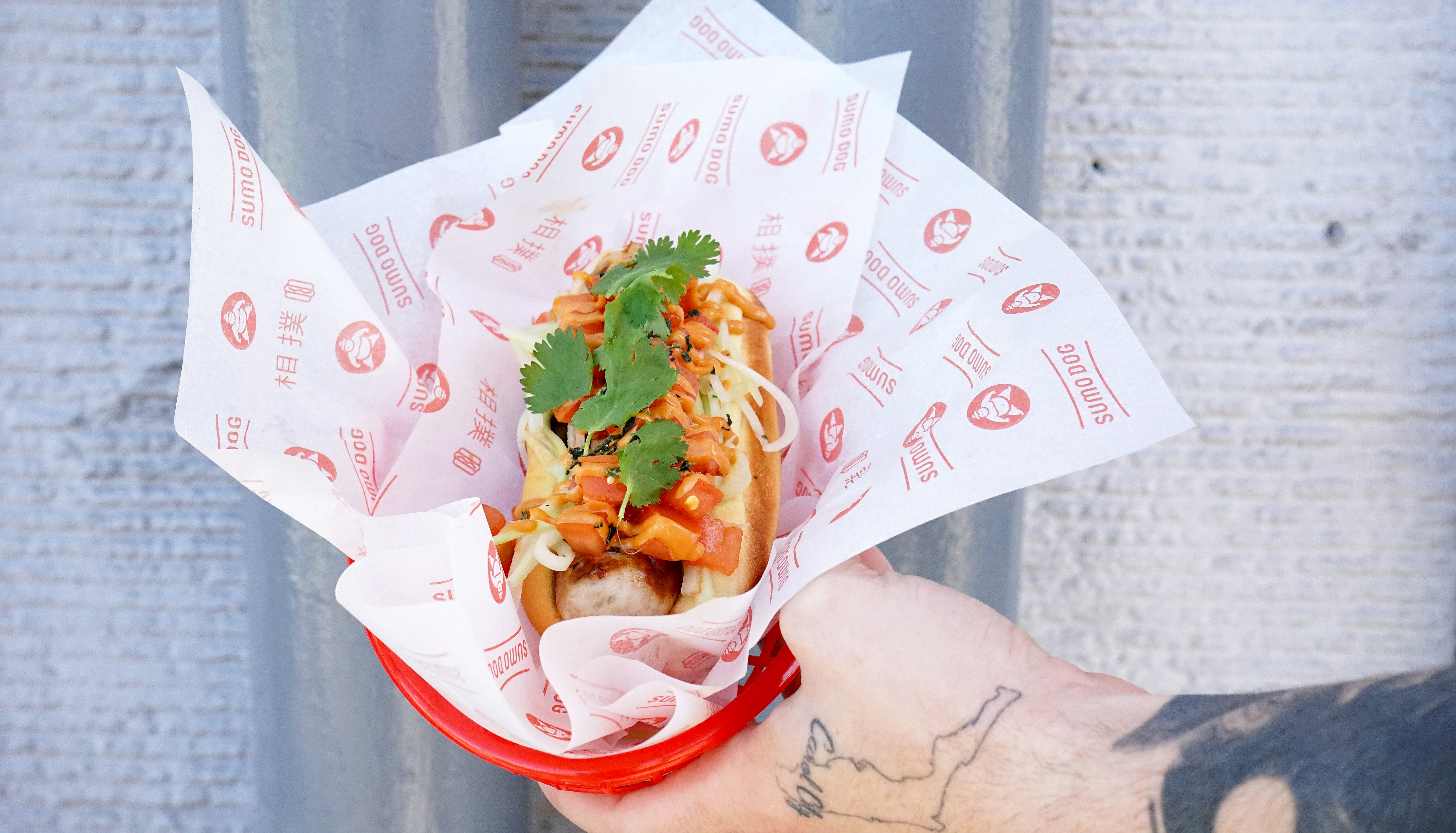All the Terms to Know When You Want to Be a Foodie or Restaurant Blogger

[All photos in this post where taken by Huong Nguyen of Heartlab Co. at Loit Cafe]
I wish I could say that I know everything, but I don’t.
Sure when I’m having an argument and I’m getting louder than the person disagreeing with me, I sound like I know it all. However, chances are I simply look like I know what I’m talking about. I’m good at pretending to know things and this was very true when I first started Follow My Gut. During the first couple of weeks, ok months, I had with this blog there were times when someone would tell me something that I had no understanding on. As time passed, I would either Google the phrase or just admit, “I’ don’t know what you’re talking about…”. Since then I think I have a pretty good handle on all the commonly used phrases when it comes to blogging about restaurants. In an effort to prevent others from going through the same struggle I experienced, I’ve pulled together all the terms and phrases I’ve heard.
In no particular order, here are all the things that made me scratch my head at some point.
In the world of food, social media, and the internet there are so many ways to say what we do, but three terms really sum it up best. Those words are foodie: food blogger, and a food instagrammer/influencer. While you can be all three, for the sake of brevity you should pick one and then elaborate later.
Foodie
A “foodie” is a broad term to describe a person who loves food. It pertains to anyone who loves to continuously put food in their mouth, talk about food, cook, or dine out. If you like food and you even enjoy sharing that with others via social media, you’re a foodie. However, some people with traditional views reserve that term to refer to people who have a refined palate or who have years of culinary experience. They get irate when “foodie” is used for anyone outside of that and would like people to stop using it.
When I see those people begin to get aggravated I say a quick prayer and then walk away. “Dear God, please bless this person with the ability to chill the hell out because it’s not that serious. Amen.” Getting upset about a food lover calling themselves a foodie is a pointless battle in 2018 because it’s too prevalent to stop its use. Redirect that energy at a legitimate issue such as someone calling themselves a veteran although they’ve never served in a war.
Food Blogger
A food blogger is exactly what its name says. It describes a person who would be considered a foodie, but it incorporates that they have a website or a blog that they manage and update regularly. It’s important to know that they have a website because it says the person has created an online space that they own and can do with as they wish. I consider myself to be a food blogger because I own FollowMyGut.com and use it to talk about restaurants. Additionally, understanding that a person has a blog lets you know that they’ve most likely put added effort into what they’re doing. It goes beyond editing and posting a photo. It’s editing a photo, writing a caption, creating posts, SEO management, site maintenance, renewal costs, and much more. Looking for another perfect example, Gigi Eats Celebrities is this exactly!
Now, when it comes to the explicit definitions of a food writer/journalist, critic, etc. we’ll save that for a future post.
Food Instagrammer/Influencer
I know a lot of people with Instagram accounts who don’t have their own website and they are killing it! Hungry Hugh is a perfect example of this and add to that, he’s a really nice person. People who put their work solely on a social media platform like Instagram are best described as Instgrammers because it immediately lets you know where you can find the majority of their work. An Instgrammer can often overlap with an “influencer” as most individuals (not all) who have a strong presence on Instagram can influence their followers to a certain action. In the case of Hugh and others like him, he can post a photo of food from Chic Fil A and incite hunger in his followers to the point they want to visit the restaurant. I mean, I already like Chic Fil A but when I see him post a photo I often feel the need to go to the nearest location—even if I just left.
[EXTRA!]
Plus One
Sure this one isn’t about you, but you’ll hear it a lot when it comes to attending media dinners and tastings (both explained below). A plus one is a guest you bring along with you to events. It can be whomever you would like, but please know you should be careful who you bring. Some people have zero etiquette, feel entitled, or just aren’t good company and they can make it hard for you to review the restaurant. Instead, bring friends you know will enjoy being around and who can be patient with what you’re doing.
One last thing: when your friend goes with you their food will be comped (explained below), but you still have to tip according to the total bill. With that said, if your friend eats like Jabba the Hutt, you’ll be tipping 15%, 18%, or 20% on a Jabba bill so please have Jabba money.
One of the most exciting and heartwarming parts to what we do is that many restaurants have events to introduce you to their food, and it’s free. You read that right: FREE! To distinguish between what’s what, check out the three terms below.
Look up the word, ‘complimentary’ in the dictionary and head straight to the noun and you’ll see one of my all-time favorite words. Dictionary.com breaks down the word to mean: “something given or supplied without charge”. Complimentary food (or comped for short) is simply free food. When you get an invitation to a dinner or an event, 99% of the time the food or the ticket will be free because you’re doing a trade with the restaurant. If it’s not free, then it’s not free. Restaurants trade with you is on the understanding that you will give them honest reviews and promote what you ate online or via social media.
Media Dinners
An invitation to a media dinner (or breakfast, brunch, or lunch) is where a publicist or restaurant brings together a group of people who are connected to the food media in some way. Whether a person is a food critic for a magazine, an independent food blogger, or food podcaster they can all show up at the event. Not to be forgotten, often times you’ll run into folks who aren’t directly connected to food, but have a great reach to an audience (i.e. news anchor or fashion Youtuber).
Tipping can be confusing at media dinners. Since so much food is brought out to the table the question can be do you tip on the entire table or only what you ate. My rule of thumb: ask. A lot of the times, the publicist will be at these events and you can be straight with them. “Hey, is it cool to tip the staff?” They’ll either tell you yes or let you know they are tipping the staff on your behalf. In the instance that there is no publicist to ask, then the best thing to do is to find the waitress or waiter who helped you and tip them directly. I mean, they just juggled a big table of hungry people so giving them something to say thank-you isn’t that hard.
Tastings
A tasting is just like a media dinner only with fewer people or it’s just for yourself and your plus one. The majority of times, it’s the latter. Most often, it refers to an  invitation to dine at a restaurant for free food at a day and time that you can coordinate with the publicist around the restaurant’s hours. What makes this different from a media dinner is that you can go on your own or with a plus one. Tastings are ideal for the person who is introverted and doesn’t want to be around a lot of unfamiliar faces. They are also great because there’s very little distraction or interruption while you’re taking photos. No one grabs the plate you’re about to photograph and you don’t have to wait for someone to finish taking their pictures.
invitation to dine at a restaurant for free food at a day and time that you can coordinate with the publicist around the restaurant’s hours. What makes this different from a media dinner is that you can go on your own or with a plus one. Tastings are ideal for the person who is introverted and doesn’t want to be around a lot of unfamiliar faces. They are also great because there’s very little distraction or interruption while you’re taking photos. No one grabs the plate you’re about to photograph and you don’t have to wait for someone to finish taking their pictures.
The main drawback when comparing a tasting to media dinner is there will not be as much food. Media dinners can have a handful of people allowing there to be greater opportunities to photograph an entire menu or fairly close to it. At a tasting, you’re generally limited to order a few dishes that can cap off at the restaurants discretion. Knowing that, order what you think is best and photograph until you feel like you got exactly what you need.
[EXTRA!]
Prix Fixe Menu
With an invitation to a media dinner or tasting, you may be told that the restaurant has a prix fixe menu. The nice French sounding phrase means fixed price and pertains to a menu of previously selected items that are served in courses all for a set price. The chef designs a menu with items that he thinks either best showcase the restaurant or fits a holiday or season. You’ll see this often when an ingredient is in season (i.e. pumpkin) or around a celebratory date like Thanksgiving, Christmas, or graduations.
That menu will then be laid out in order of an ideal “flow” (starter to entrée to dessert) and then served at a particular price. Although the menu will be comped if it’s a trade, it’s important to know that under many instances, it can’t be altered. Allergies tend to be the only time a menu may be amended – or unless you’re really cool with the location. Feel free to ask to see if it can be done, but understand that most restaurants won’t alter a menu if the purpose is to promote it as is.
Rates
As you post to Instagram and update your website regularly brands and publicists will start to reach out to you to work with them. While some offer trade, others want to know your rates. “Rates” is the amount of money you charge to offer your services. The best way to determine this is to consider all aspects of the work. Look at the scope of work and decide how much time will be needed, if travel is necessary, what content you will deliver, and how much you would like to receive based on the company’s budget. Once you have all of that together, send your rates their way and keep your fingers crossed that they accept your number.
Partnership/Collaboration
I’ve found that whenever a person connects with me about a partnership or collaboration, it’s generally a trade relationship. “We’d love to collaborate with you on (insert opportunity here)” is most often a professional way of  saying a business would like to work with you on a trade agreement. Prior to agreeing to any part of a partnership or collaboration, ask whether it’s paid or not, what they’re offering you, what they’re looking to receive, and when they expect to receive it. Even if it’s not a paid partnership it’s a working relationship so it’s essential that you know what it entails so you can do the job right.
saying a business would like to work with you on a trade agreement. Prior to agreeing to any part of a partnership or collaboration, ask whether it’s paid or not, what they’re offering you, what they’re looking to receive, and when they expect to receive it. Even if it’s not a paid partnership it’s a working relationship so it’s essential that you know what it entails so you can do the job right.
Post About the Restaurant
This one you have to be very clear on because assumptions can easily be made. Often, you’ll be asked to “post about the restaurant” and that single line can be so vague. Does “post” mean Instagram post, post to your website (if you have one), or both? To avoid any confusion and delivery of the wrong expectation, clarify before agreeing to do anything. Make sure that you and the publicists are on the same page in regards to what you’ll be doing for them. Is it something that is posted to Instagram Stories, all of your social media accounts, your website only, or a unique cocktail of all the above? If you’ve never worked with the company before ask what they’re looking to have done and if it meets your comfortability or rate, go with it.
Rights to Creative Content
Say you post a photo to Instagram about a restaurant and then a few weeks later you go into the restaurant and you find your photo is printed on their menu. Is that ok with you? Yes they gave you free food and you posted and tagged them, but a gray area happens when you find a business uses your creative content in their marketing material without your permission. Decide on what matters to you early on. Is credit enough, payment, or both? Whatever you decide, know that your work should be compensated accordingly if it’s being used in certain ways. If you find they use your material without your permission in the same way they would if they hired a photographer of videographer, then you should be paid. Doing the opposite is a cheap way to get around paying freelance photogrpaher, but it’s not fair to you. If you get that vibe from a business, send them your rates because you should be compensated.
Period, the end.
Although I didn’t know all the food terminology when I started, I’m glad I was able to learn it as time went on. Sure it was rocky having to pretend, but to be able to know these terms now make restaurant blogging so much easier. Hopefully this list helps you along your food blogging journey and you won’t have to Google ferociously to figure out a strange word or phrase.
Share this:
- Click to share on Facebook (Opens in new window)
- Click to share on Twitter (Opens in new window)
- Click to share on Tumblr (Opens in new window)
- Click to share on Pinterest (Opens in new window)
- Click to share on LinkedIn (Opens in new window)
- Click to email a link to a friend (Opens in new window)
- Click to print (Opens in new window)

Follow My Gut
Follow My Gut is a restaurant discovery blog created to help people find restaurants and indulge in food. There's great food in restaurants and those finds should be shared! If you feel the same way and want to join in new and forgotten discoveries, all you have to do is Follow My Gut by subscribing. You can also stay up to date on all food finds on Facebook and Instagram at @FollowMyGut!
2 Comments
Comments are closed.






I learn so much from this post even though I’m not really a food blogger! I did however post about a restaurant I visited here in my hometown on my blog and had fun writing it because you know, I love food so much and cannot relate to those who don’t. I received the special email on my blog and utterly loved the photos and content you created for us and had to pop by to say hi. Love the pictures of you and what you wore here and the nail color, Danielle. It has been a while since I visited and I just want to send you my virtual hugs….and I will be stalking your posts soon. Missed reading you 🙂 x
Love your post I like to consider my self a foodie, but I feel like I can now be one step closer to being a real foodie!